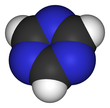1,3,5-Triazine
| |||
| Names | |||
|---|---|---|---|
| Preferred IUPAC name
1,3,5-Triazine[1] | |||
| Other names
sym-Triazine
s-Triazine Cyanidine Hydrogen cyanide trimer Vedita | |||
| Identifiers | |||
3D model (JSmol)
|
|||
| ChEBI | |||
| ChEMBL | |||
| ChemSpider | |||
| ECHA InfoCard | 100.005.481 | ||
| EC Number |
| ||
PubChem CID
|
|||
| RTECS number |
| ||
| UNII | |||
CompTox Dashboard (EPA)
|
|||
| |||
| |||
| Properties | |||
| C3H3N3 | |||
| Molar mass | 81.08 g/mol | ||
| Appearance | White crystalline solid | ||
| Melting point | 81 to 83 °C (178 to 181 °F; 354 to 356 K) | ||
| Structure | |||
| planar | |||
| zero | |||
| Hazards | |||
| Occupational safety and health (OHS/OSH): | |||
Main hazards
|
Sensitive to water | ||
| GHS labelling: | |||
  
| |||
| Danger | |||
| H302, H314, H315, H335, H360 | |||
| P201, P202, P260, P261, P264, P270, P271, P280, P281, P301+P312, P301+P330+P331, P302+P352, P303+P361+P353, P304+P340, P305+P351+P338, P308+P313, P310, P312, P321, P330, P332+P313, P362, P363, P403+P233, P405, P501 | |||
| Related compounds | |||
Except where otherwise noted, data are given for materials in their standard state (at 25 °C [77 °F], 100 kPa).
| |||
1,3,5-Triazine, also called s-triazine, is an organic chemical compound with the formula (HCN)3. It is a six-membered heterocyclic aromatic ring, one of several isomeric triazines. S-triazine—the "symmetric" isomer—and its derivatives are useful in a variety of applications.
Preparation
[edit]Symmetrical 1,3,5-triazines are prepared by trimerization of certain nitriles such as cyanogen chloride or cyanamide. Benzoguanamine (with one phenyl and 2 amino substituents) is synthesised from benzonitrile and dicyandiamide.[2] In the Pinner triazine synthesis (named after Adolf Pinner)[3] the reactants are an alkyl or aryl amidine and phosgene.[4][5] Insertion of an N-H moiety into a hydrazide by a copper carbenoid, followed by treatment with ammonium chloride also gives the triazine core.[6]
Amine-substituted triazines called Guanamines are prepared by the condensation of cyanoguanidine with the corresponding nitrile:[7]
- (H2N)2C=NCN + RCN → (CNH2)2(CR)N3
Applications
[edit]As a reagent in organic synthesis, s-triazine is used as the equivalent of hydrogen cyanide (HCN). Being a solid (vs a gas for HCN), triazine is sometimes easier to handle in the laboratory. One application is in the Gattermann reaction, used to attach the formyl group to aromatic substrates.[8]
Triazine derivatives
[edit]N- and C-substituted triazines are used industrially. The most common derivative of 1,3,5-triazine is 1,3,5-triazine-2,4,6-triamine, commonly known as melamine or cyanuramide. Another important derivative is 1,3,5-triazine-2,4,6-triol better known as cyanuric acid.
Cyanuric chloride (2,4,6-trichloro-1,3,5-triazine) is the starting point for the manufacture of many herbicides such as Simazine and atrazine. Chlorinated triazines are the basis of an important family of reactive dyes, which are covalently attached to cellulosic materials.[9]

Triazines are also found in pharmaceutical products.[10]
References
[edit]- ^ Nomenclature of Organic Chemistry : IUPAC Recommendations and Preferred Names 2013 (Blue Book). Cambridge: The Royal Society of Chemistry. 2014. p. 147. doi:10.1039/9781849733069-FP001. ISBN 978-0-85404-182-4.
- ^ Benzoguanamine J. K. Simons and M. R. Saxton Organic Syntheses Coll. Vol. 4, p.78; Vol. 33, p.13 Article Archived 2012-07-16 at the Wayback Machine
- ^ A. Pinner, Ber. 23, 2919 (1890)
- ^ Name reactions and reagents in organic synthesis, Bradford P. Mundy, Michael G. Ellerd, Frank G. Favaloro
- ^ Schroeder, Hansjuergen; Grundmann, Christoph (1956). "Triazines. XIV. The Extension of the Pinner Synthesis of Monohydroxy-s-triazines to the Aliphatic Series. 2,4-Dimethyl-s-triazine1-3". Journal of the American Chemical Society. 78 (11): 2447–2451. doi:10.1021/ja01592a028.
- ^ Shi, Baolu; Lewis, William; Campbell, Ian B.; Moody, Christopher J. (2009). "A Concise Route to Pyridines from Hydrazides by Metal Carbene N−H Insertion, 1,2,4-Triazine Formation, and Diels−Alder Reaction". Organic Letters. 11 (16): 3686–3688. doi:10.1021/ol901502u. PMID 19719202.
- ^ J. K. Simons; M. R. Saxton (1953). "Benzoguanamine". Org. Synth. 33: 13. doi:10.15227/orgsyn.033.0013.
- ^ Böhme, Roswitha M.; Dang, Qun (2008). "1,3,5-Triazine". Encyclopedia of Reagents for Organic Synthesis. doi:10.1002/047084289X.rt158.pub2. ISBN 978-0471936237.
- ^ Tappe, Horst; Helmling, Walter; Mischke, Peter; Rebsamen, Karl; Reiher, Uwe; Russ, Werner; Schläfer, Ludwig; Vermehren, Petra (2000). "Reactive Dyes". Ullmann's Encyclopedia of Industrial Chemistry. doi:10.1002/14356007.a22_651. ISBN 3527306730.
- ^ Aksenov, A. V.; Aksenova, I. V. (2009). "Use of the ring opening reactions of 1,3,5-triazines in organic synthesis (Review)". Chemistry of Heterocyclic Compounds. 45 (2): 130–150. doi:10.1007/s10593-009-0243-5. S2CID 94191027.


